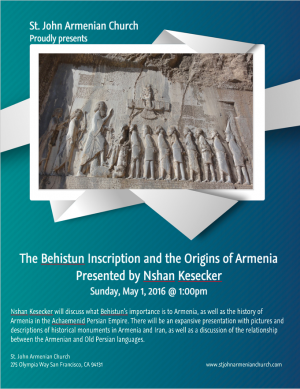Nshan Kesecker will discuss what Behistun’s importance is to Armenia, as well as the history of Armenia in the Achaemenid Persian Empire. There will be an expansive presentation with pictures and descriptions of historical monuments in Armenia and Iran, as well as a discussion of the relationship between the Armenian and Old Persian languages.
Armenia is a nation with ancient roots. However, despite the heroic efforts of Movses Khorenatsi to preserve the beginnings of Armenian history, the narrative is anything but clear. Though names such as Subartum (Sumerian), Hayasa (Hittite), Biainili (Urartian), and Urartu/Ararat (Akkadian) appear in texts from the mid-second millennium to describe the Armenian Highland (or parts of it), the first time the name Armenia is used in in the Behistun Inscription. This text, composed in at least four languages (Old Persian, Elamite, Babylonian, and Aramaic), was composed around the turn of the 6th century BC at the behest of the Persian king, Darius I (522-486). The Old Persian and Elamite versions of the text use the term “Armenia” for the first time in recorded history.
